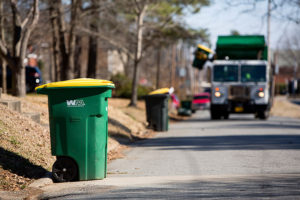Consumers in the Loop (Craig Douglass On Consumers)
by Craig Douglass on Monday, Dec. 3, 2018
National Recycling Day was marked last month as it has been every year since 1997. This annual observance is sponsored by Keep America Beautiful with the objective of encouraging Americans to buy recycled products.
“By reducing our waste and increasing our recycling, we can convert waste into reusable material,” as the national promotional material puts it. To be clear, we can only put reusable material back into the manufacturing process if we divert otherwise recyclable material from landfills.
The notion and practice of buying recycled products makes an important point: Recycling is a business; it’s transactional, subject to market pressures and the critical law of supply and demand. In the recycling business it’s called the closed loop. And consumers are part of and critically necessary to make the loop work.
Here’s the deal.
Recycling begins with the consumer, those of us who regularly discard recyclable materials into a curbside-recycling cart. You know, the green cart with the yellow top that you roll out to the curb. The process ends, or the loop is closed, when manufacturing companies buy recycled materials to reuse as raw components for new products. If there are no consumers to separate recyclable materials from trash and deposit them in the recycling carts and, likewise, if there are no manufacturing customers to buy the recyclable material, there is no recycling. It simply won’t work.
So, consumers begin the process. Part of the responsibility is doing recycling right by never putting plastic bags, regardless of content, in the recycling cart. And we are instructed that if there is a doubt about what goes in the curbside cart, we stick to the basics. Here they are:
- Cans — aluminum, tin and steel (empty and rinsed of food);
- Plastic bottles and jugs — water bottles, milk jugs and any plastic container that has an opening at the top that is smaller than the base at the bottom (empty and rinsed with caps left on);
- Paper — office paper, newspaper, mailers, magazines, catalogs and phone books (but no hardback books); and
- Cardboard and paperboard — shipping boxes, cereal and food boxes (with all plastic liners, bubble wrap and Styrofoam packing materials removed and trashed; make sure cardboard boxes are broken down and flattened out to fit inside the recycling cart).
Now, those consumers who pay attention to recycling have no doubt heard about the impact on American recycling by China no longer accepting or significantly limiting the type of scrap materials it has long purchased from American recycling companies. The fact is, China and other offshore markets will simply no longer accept recycled materials of low quality. That means material contaminated with nonreusable trash that makes using the otherwise clean recyclable material more costly and less efficient in the manufacturing process. And this practice of turning away “dirty” shipments of would-be recycled material has sent commodity prices plummeting because there is a glut of material left on the market. Remember: supply and demand. If the Chinese are no longer buying it, but all of us here are continuing to recycle it, there’s more supply than demand. And that affects all consumers who, through their participation in recycling, are in the loop.
What must be done? Well, the first thing we are asked to do is make sure we understand we as consumers are a key part of the closed-loop recycling industry. And as such we should put only acceptable recyclable materials in our recycling cart. Just because you put something in your cart and close the lid doesn’t mean it gets recycled.
Out of sight, out of mind. Right?
Wrong. If the whole recycling process is to work — and the process starts with consumers — then we have to keep in mind how to do recycling right. In a changing marketplace, of which we all are a part, that’s more important than ever.
We consumers should consider ourselves producers of raw materials necessary for making new products. As producers, we certainly want to provide the best quality product possible, a product others will buy. It’s part of being good stewards of the environment and keeping recyclable materials — reusable raw materials — out of landfills. The first step in the loop is to take time to learn how to do recycling right so an effective recycling program can continue for all of us. Without buyers at the end of the loop, it all ends up as trash.

